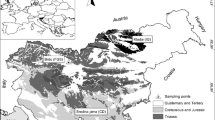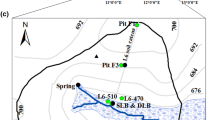Abstract
Despite intensive biogeochemical research during the last thirty years, the relative importance of biological S turnover for the overall SO 2-4 budget of forested catchments remains uncertain. The objective of the present study was (i) to gain new insight into the S cycle of the Lehstenbach catchment (Northeastern Bavaria, Germany) through the analysis of stable isotopes of S and (ii) to differentiate between sites which are ‘hot spots’ for SO 2-4 reduction and sites where mineralization and adsorption/desorption processes are more important. The δ34S values and SO 2-4 concentrations of soil solutions, throughfall and groundwater at four different sites as well as runoff of the catchment were measured. The relatively low variability of δ34S in throughfall and bulk precipitation was in contrast to the high temporal and spatial variability of δ34S in the soil solution. Sulfate in the soil solution of upland sites was slightly depleted in 34S compared to input values. This was most likely due to S mineralization. Sulfate in the soil solution from wetland soils was clearly enriched in 34S, indicating dissimilatory SO 2-4 reduction. The observed spatial and temporal patterns of 34S turnover and SO 2-4 concentrations might explain the overall balanced S budget of the catchment. At a time of decreasing anthropogenic deposition SO 2-4 is currently released from upland soils. Furthermore, mineralization of organic S may contribute to SO 2-4 release. Wetland soils in the catchment represent a sink for SO 2-4 due to dissimilatory SO 2-4 reduction.
Similar content being viewed by others
References
Alewell C & Giesemann A (1996) Sulfate Reduction in a forested catchment as indicated by δ 34S of soil solutions and runoff. Isotopes in Environmental and Health Studies 32: 203-210
Alewell C (1998) Investigating sulfate sorption and desorption of acid forest soils with special consideration of soil structure. J. Soil Sci. Plant Nutrition 161: 73-80
Alewell C, Mitchell M, Likens GE & Krouse HR (1999) Sources of stream sulfate at the Hubbard Brook Experimental forest: Long-term analyses using stable isotopes. Biogeochemistry 44: 281-299
Caron F, Tessier A, Kramer JR, Schwarcz HP & Rees CE (1986) Sulfur and oxygen isotopes of sulfur in precipitation and lake water, Quebec, Canada. Appl. Geochem. 1: 601-606
David MB, Mitchell, MJ & Schindler SC (1984) Dynamics of organic and inorganic sulfur constituents in hardwood forest soils. In: Stone EL (Ed) Forest Soils and Treatment Impacts; Sixth North American Forest Soil Conference (pp 221-245). Knoxville, Tenn., U.S.A.
David MB, Mitchell MJ & Scott MT (1987) Importance of biological processes in the sulfur budget of a northern hardwood ecosystem. Biol. Fertil. Soils 5: 258-264
Fuller RD, Mitchell MJ, Krouse HR, Wyskowski BJ & Driscoll CT (1986) Stable sulfur isotope ratios as a tool for interpreting ecosystems sulfur dynamics. Water Air and Soil Pollution 28: 163-171
Krouse HR & Grinenko VA (1991) Stable Isotopes. Natural and Anthropogenic Sulphur in the Environment. Scope 43, John Wiley & Sons Ltd.
Krouse HR, Stewart JWB & Grinenko VA (1991) Pedosphere and Biosphere. In: Krouse HR & Grinenko VA (ED) Stable Isotopes. Natural and Anthropogenic Sulphur in the Environment (pp 267-306). Scope 43, John Wiley & Sons Ltd.
Manderscheid B & Matzner E (1995) Spatial and temporal variability of soil solution chemistry and seepage water ion fluxes in a mature Norway spruce (Picea abies (L.) Karst.) stand. Biogeochem. 30: 99-114
Manderscheid B, Schweisser T, Lischeid G, Alewell C & Matzner E (1998) Sulfate pools in the weathered bedrock of a forested catchment. Soil Sci. Soc. Am. J. (submitted)
Mayer B, Feger KH, Giesemann A & Jäger H-J (1995a) Interpretation of sulfur cycling in two catchments in the Black Forest (Germany) using stable sulfur and oxygen isotope data. Biogeochem. 30: 31-58
Mayer B, Fritz P, Prietzel J & Krouse HR (1995b) The use of stable and oxygen isotope ratios for interpreting the mobility of sulfate in aerobic forest soils. Appl. Geochem. 10: 161-173
McLaren RG, Keer JI & Swift RS (1985) Sulphur transformations in soils using sulphur-35 labeling. Soil Biol. Biochem. 17: 73-79
Mitchell MJ, Driscoll CT, Fuller RD, David MB & Likens GE (1989) Effect of whole-tree harvesting on the sulfur dynamics of a forest soil. Soil Sci. Soc. Am. J. 53: 933-940
Mitchell MJ, David MB, Maynard DG & Telang SA (1985) Sulfur constituents in soils and streams of a watershed in the Rocky Mountains of Alberta. Can. J. For. Res. 16: 315-320
Mitchell MJ, Krouse HR, Mayer B, Stam AC & Zhang YM (1998) Use of stable isotopes in evaluating biogeochemistry of forest ecosystems. In: McDonnell & Kendall C (Ed) Isotope Tracers in Catchment Hydrology. Elsevier, The Netherlands (in press)
Mückenhausen E (1993) Die Bodenkunde und ihre geologischen, geomorphologischen, mineralogischen und petrologischen Grundlagen. DLG-Verlag Frankfurt am Main, 1-579
Novak M, Bottrell SH, Groscheova H, Buzek F & Cerny J (1995) Sulphur isotope characteristics of two North Bohemian forest catchments. Water Air and Soil Pollution 85: 1641-1646
Stam AC, Mitchell MJ, Krouse HR & Kahl JS (1992) Stable sulfur isotopes of sulfate in precipitation and stream solutions in a northern hardwood watershed. Water Resour. Res. 28: 231-236
Van Stempvoort DR & Wills JJ (1991) Aboveground vegetation effects on the deposition and cycling of atmospheric sulfur: Chemical and stable isotope evidence. Water Air and Soil Pollution 60: 55-82
Torssander P & Mörth C-M (1997) Sulfur dynamics in the roof experiment at Lake Gårdsjön deduced from sulfur and oxygen isotope ratios in sulfate. In: Hultberg H & Skeffington R (Eds) Experimental Reversal of Acid Rain Effects: The Gårdsjön Roof Project (pp 1-466). John Wiley & Sons, Chichester, U.K.
Zhang Y (1994) Biogeochemistry of forest soils at the Hubbard Brook Experimental Forest, New Hampshire: an experimental approach. PhD Dissertation. SUNY, College of Environmental Science and Forestry, Syracuse, NY, U.S.A.
Zhang Y, Mitchell MJ, Christ M, Likens GE & Krouse HR (1998): Stable sulfur isotopes at the Hubbard Brook Experimental Forest, New Hampshire. Biogeochem. (in press)
Author information
Authors and Affiliations
Rights and permissions
About this article
Cite this article
Alewell, C., Gehre, M. Patterns of stable S isotopes in a forested catchment as indicators for biological S turnover. Biogeochemistry 47, 317–331 (1999). https://doi.org/10.1023/A:1006149804696
Issue Date:
DOI: https://doi.org/10.1023/A:1006149804696




